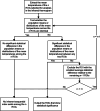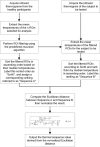Preliminary study on objective evaluation algorithm of human infrared thermogram seriality and its clinical application in population with metabolic syndrome
- PMID: 40578850
- PMCID: PMC12207182
- DOI: 10.1136/bmjhci-2024-101252
Preliminary study on objective evaluation algorithm of human infrared thermogram seriality and its clinical application in population with metabolic syndrome
Abstract
Objectives: To develop an objective evaluation algorithm for assessing the seriality of infrared thermograms for the auxiliary diagnosis of diseases, and to internally validate the algorithm using metabolic syndrome (MS) as a case example.
Methods: A total of 266 healthy participants (133 of each sex) and 180 patients with MS (133 males and 47 females) were retrospectively enrolled. Infrared thermograms were randomly divided into a training set and a validation set at a ratio of 3:1. According to the algorithm proposed in this article, the thermal sequence values of patients with MS were calculated and compared between the two groups. The area under the curve (AUC) was computed to evaluate the diagnostic performance of thermogram seriality in MS detection.
Results: The established thermal sequence of healthy participants was as follows: T palm<T lower leg<T lower abdomen. In the training set, the AUCs for male and female patients with MS were 0.77 and 0.72, respectively, while in the validation set, they were 0.76 and 0.69, respectively. And results indicated that thermogram seriality demonstrated better diagnostic stability in males and in younger and middle-aged individuals. Additionally, higher body mass index values showed a positive correlation with increased thermal sequence values.
Discussion: The study proposed a novel, objective algorithm for quantitatively evaluating thermogram seriality. By focusing on temperature sequences rather than absolute temperature values, the algorithm is expected to facilitate a more quantitative evaluation of thermogram features. It could improve the stability and reproducibility of MS diagnosis.
Conclusion: The algorithm can quantitatively characterise thermogram seriality and can be used for the auxiliary screening of MS.
Keywords: BMJ Health Informatics; Computing Methodologies; Decision Support Systems, Clinical.
© Author(s) (or their employer(s)) 2025. Re-use permitted under CC BY-NC. No commercial re-use. See rights and permissions. Published by BMJ Group.
Conflict of interest statement
Competing interests: None declared.
Figures





Similar articles
-
Cost-effectiveness of using prognostic information to select women with breast cancer for adjuvant systemic therapy.Health Technol Assess. 2006 Sep;10(34):iii-iv, ix-xi, 1-204. doi: 10.3310/hta10340. Health Technol Assess. 2006. PMID: 16959170
-
Signs and symptoms to determine if a patient presenting in primary care or hospital outpatient settings has COVID-19.Cochrane Database Syst Rev. 2022 May 20;5(5):CD013665. doi: 10.1002/14651858.CD013665.pub3. Cochrane Database Syst Rev. 2022. PMID: 35593186 Free PMC article.
-
Intravenous magnesium sulphate and sotalol for prevention of atrial fibrillation after coronary artery bypass surgery: a systematic review and economic evaluation.Health Technol Assess. 2008 Jun;12(28):iii-iv, ix-95. doi: 10.3310/hta12280. Health Technol Assess. 2008. PMID: 18547499
-
Home treatment for mental health problems: a systematic review.Health Technol Assess. 2001;5(15):1-139. doi: 10.3310/hta5150. Health Technol Assess. 2001. PMID: 11532236
-
Eliciting adverse effects data from participants in clinical trials.Cochrane Database Syst Rev. 2018 Jan 16;1(1):MR000039. doi: 10.1002/14651858.MR000039.pub2. Cochrane Database Syst Rev. 2018. PMID: 29372930 Free PMC article.
References
-
- Calin MA, Mologhianu G, Savastru R, et al. A review of the effectiveness of thermal infrared imaging in the diagnosis and monitoring of knee diseases. Infrared Phys Technol 2015;69:19–25. 10.1016/j.infrared.2015.01.013 - DOI
MeSH terms
LinkOut - more resources
Full Text Sources
Medical
